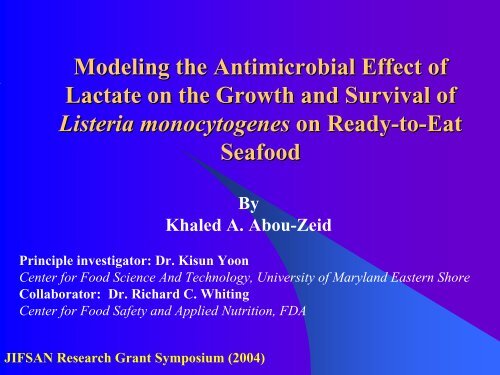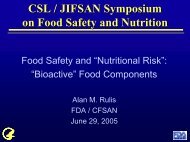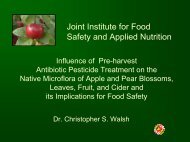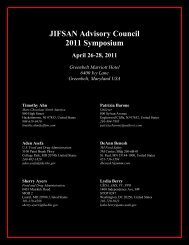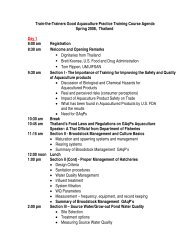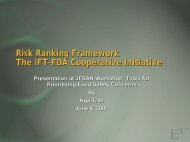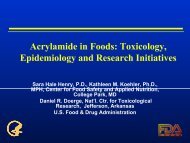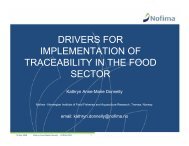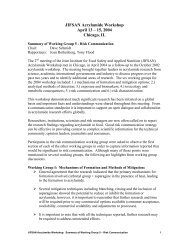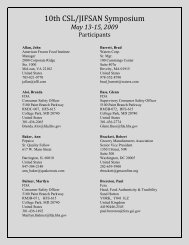Predictive Modeling for Listeria monocytogenes as a ... - jifsan
Predictive Modeling for Listeria monocytogenes as a ... - jifsan
Predictive Modeling for Listeria monocytogenes as a ... - jifsan
Create successful ePaper yourself
Turn your PDF publications into a flip-book with our unique Google optimized e-Paper software.
<strong>Modeling</strong> the Antimicrobial Effect of<br />
Lactate on the Growth and Survival of<br />
<strong>Listeria</strong> <strong>monocytogenes</strong> on Ready-to<br />
to-Eat<br />
Seafood<br />
By<br />
Khaled A. Abou-Zeid<br />
Principle investigator: Dr. Kisun Yoon<br />
Center <strong>for</strong> Food Science And Technology, University of Maryland E<strong>as</strong>tern Shore<br />
Collaborator: Dr. Richard C. Whiting<br />
Center <strong>for</strong> Food Safety and Applied Nutrition, FDA<br />
JIFSAN Research Grant Symposium (2004)
<strong>Listeria</strong> <strong>monocytogenes</strong><br />
• The genus <strong>Listeria</strong> includes 6 different species (L.<br />
<strong>monocytogenes</strong>, L. ivanovii, L. innocua, L. welshimeri,<br />
L. seegligeri, and L. grayi).<br />
• Both L. ivanovii and L. <strong>monocytogenes</strong> are pathogenic<br />
<strong>for</strong> mice, but only L. <strong>monocytogenes</strong> is consistently<br />
<strong>as</strong>sociated with human illness
<strong>Listeria</strong> <strong>monocytogenes</strong><br />
• Causes septicemia, abortion and encephalitis in<br />
humans and more than 40 animal species, but is also<br />
common in environment<br />
• Ubiquitous in the environment, can survive <strong>for</strong><br />
prolonged periods in the environment (apparently<br />
outside a host)<br />
• Human listeriosis can occur <strong>as</strong> epidemic and sporadic<br />
c<strong>as</strong>es<br />
• Affects predominantly elderly and immunocompromised<br />
people, pregnant women and newborns.
<strong>Listeria</strong> <strong>monocytogenes</strong><br />
• Approx. 2500 human c<strong>as</strong>es/year in the U.S.,<br />
resulting in about 500 deaths/year<br />
• L. <strong>monocytogenes</strong> is one of the major microbial<br />
contaminants of ready to eat food, such <strong>as</strong><br />
smoked salmon
Factors Controlling <strong>Listeria</strong> in smoked<br />
fish<br />
• Smoking<br />
• pH<br />
• Water activity<br />
• Competitive microorganism<br />
• Preservatives: antimicrobial compounds
Antimicrobial compound used:<br />
Pur<strong>as</strong>al P Opti.Form 4, ( PURAC America Inc. )<br />
• Pot<strong>as</strong>sium lactate (PL)/ sodium diacetate (SD) ratio<br />
of 14:1 (56% PL and 4% SDA)<br />
• Its antimicrobial effect on growth and survival of<br />
L. <strong>monocytogenes</strong> <strong>as</strong> a function of temperature h<strong>as</strong><br />
not been modeled in either microbiological food<br />
products or broth.
Main objectives<br />
• To determine the antimicrobial effect of<br />
Pur<strong>as</strong>al P Opti.Form 4 on L. <strong>monocytogenes</strong><br />
in ready to eat smoked fish<br />
• To develop a model <strong>for</strong> the growth and<br />
survival of L. <strong>monocytogenes</strong> <strong>as</strong> a function of<br />
Pur<strong>as</strong>al P Opti.Form 4 concentrations
Sample preparation<br />
5g smoked salmon slice<br />
Cut into two pieces<br />
Applied Opti.Form 4<br />
Inoculated with <strong>Listeria</strong> (10 2 )<br />
Pieces were folded<br />
Vacuum packed<br />
Stored
Effect of Opti.Form 4 on the growth of<br />
L. <strong>monocytogenes</strong> at 4 ºC<br />
L. <strong>monocytogenes</strong><br />
log10CFU/ml<br />
10<br />
8<br />
6<br />
4<br />
2<br />
0<br />
1.8P<br />
3.3P<br />
4.5P<br />
0<br />
0 4 8 12 16 20 24 28 32<br />
day
Effect of Opti.Form 4 on the growth of<br />
L. <strong>monocytogenes</strong> at 10 ºC<br />
L. <strong>monocytogenes</strong><br />
log10CFU/ml<br />
10.0<br />
7.5<br />
5.0<br />
2.5<br />
con<br />
1.8P<br />
3.3P<br />
4.5P<br />
0.0<br />
0 5 10 15 20<br />
day
Introducing the concept of predictive<br />
modeling<br />
• In an ef<strong>for</strong>t to reduce the likelihood of contaminated food<br />
products, the concept of predictive modeling of bacterial<br />
growth becomes a prominent research topic among food<br />
microbiologists<br />
• <strong>Predictive</strong> models allow estimating shelf-life,<br />
microbiological safety of foods<br />
• Can provide an insight on how certain environmental<br />
variables affect the growth/survival profile of pathogenic<br />
or spoilage organisms
What is <strong>Predictive</strong> <strong>Modeling</strong><br />
• <strong>Predictive</strong> modeling, involves mathematical<br />
equations which have been used extensively to<br />
describe microbial behavior under various<br />
environmental factors.
Levels of predictive models<br />
1- Primary level models which describe changes of<br />
microbial numbers with time.<br />
2- Secondary level models summarize the effect of<br />
environmental conditions on parameters in the<br />
primary growth and survival models<br />
3- Tertiary level models that combine the two first levels
Objectives<br />
• To study the antimicrobial effects of<br />
different concentrations of Pur<strong>as</strong>al P<br />
Opti.Form 4 on growth and survival of<br />
L. <strong>monocytogenes</strong> in broth <strong>as</strong> a function<br />
of pH and temperature.<br />
• To develop primary models that describe<br />
growth and survival of L. <strong>monocytogenes</strong>
Objectives (cont.)<br />
• To develop secondary models <strong>for</strong> effects<br />
of temperature (4-37ºC), pH and Pur<strong>as</strong>al<br />
P Opti.Form 4 (0.0-4.5%) on specific<br />
growth rate of L. <strong>monocytogenes</strong> in<br />
broth.
Enumeration<br />
• At selected times 50 µl of cultures w<strong>as</strong><br />
spiral plated on Tryptose agar plates and<br />
incubated at 37°C <strong>for</strong> 24 hours.
• Bacterial colonies were<br />
counted with automated<br />
colony counter (Q count,<br />
Spiral Biotech Inc.<br />
Norwood, MA).<br />
• All samples were duplicated<br />
and the means were plotted<br />
at each sampling time to<br />
generate the growth curves
Primary Model<br />
Growth Curve fitting w<strong>as</strong> generated <strong>for</strong><br />
each experiment using two different<br />
functions <strong>as</strong> follow:<br />
• Baranyi model<br />
• Buchanan three-linear ph<strong>as</strong>e
Baranyi model<br />
y(t)<br />
A(t)<br />
mµ<br />
⎛<br />
max<br />
1<br />
= + µ −<br />
⎜<br />
e<br />
y<br />
+<br />
o maxA(t)<br />
ln 1<br />
m(ymax<br />
−<br />
m ⎝ e<br />
=<br />
t<br />
+<br />
1<br />
v<br />
⎛<br />
ln⎜<br />
⎝<br />
−vt<br />
e + q<br />
1+<br />
q<br />
o<br />
o<br />
⎞<br />
⎟<br />
⎠<br />
A(t)<br />
y<br />
−1⎞<br />
⎟<br />
0 )<br />
⎠<br />
where y(t) = ln x(t) with x(t) the cell concentration (CFU/ml)<br />
y o = ln x o , y max = ln(x max ), x o being the initial and x max the <strong>as</strong>ymptotic<br />
cell concentration, respectively<br />
µ max is the maximum specific growth rate (1/h)<br />
m is a curvature parameter to characterize the transition from<br />
exponential ph<strong>as</strong>e<br />
and v is the rate of incre<strong>as</strong>e of the limiting substrate q,<br />
generally <strong>as</strong>sumed to be equal to µ max
Buchanan three-linear ph<strong>as</strong>e<br />
• Buchanan et al. (1997) described bacterial growth in a very<br />
simple three-linear ph<strong>as</strong>e model. Lag ph<strong>as</strong>e:<br />
• For N t = N o<br />
• Exponential growth ph<strong>as</strong>e:<br />
• For N t = N o + µ(t-t LAG )<br />
• Stationary ph<strong>as</strong>e:<br />
• For N t = N MAX<br />
• Where N t is the log of the population density at time t ; N o<br />
the log of the initial population density; N MAX the log of the<br />
maximum population density; t the elapsed time; t LAG the<br />
time when the lag ph<strong>as</strong>e ends; t MAX the time when the<br />
maximum population density is reached; and µ is the specific<br />
growth rate (log cfu ml -1 h -1 ).
Curve fitting<br />
20<br />
18<br />
16<br />
• The growth curves were<br />
iteratively fitted to the<br />
corresponding function<br />
using a GraphPad<br />
PRISM ® <strong>for</strong> Buchanan<br />
model<br />
L. Monocytogenes lnCFU/ml<br />
14<br />
12<br />
10<br />
8<br />
6<br />
4<br />
2<br />
0<br />
0 200 400 600 800 1000 1200<br />
Hour<br />
20<br />
18<br />
16<br />
• DMFit version 2.0, an<br />
Excel add-in <strong>for</strong> fitting<br />
sigmoid curves, <strong>for</strong><br />
Baranyi model<br />
L. Monocytogenes ln CFU/ml<br />
14<br />
12<br />
10<br />
8<br />
6<br />
4<br />
2<br />
0<br />
0 200 400 600 800 1000 1200<br />
Hour
Conclusion<br />
• At pH 5.5 and all temperatures a listeriostatic effect of<br />
Pur<strong>as</strong>al P Opti.Form 4 h<strong>as</strong> been observed at all tested<br />
levels<br />
• At pH 6.0, addition of 1.8 % reduced the growth rate<br />
of L. <strong>monocytogenes</strong>, while 3% and 4.5% completely<br />
inhibited the growth over the six temperatures studied<br />
• At pH 6.5 and 7.0 the efficacy Pur<strong>as</strong>al P Opti.Form 4<br />
h<strong>as</strong> been reduced
Future Research<br />
• To develop secondary response surface models <strong>for</strong> effects<br />
of temperature, pH and different concentrations of<br />
Pur<strong>as</strong>al P Opti.Form 4 on lag time and specific growth<br />
rate of L. <strong>monocytogenes</strong> in broth<br />
• To develop and validate tertiary model <strong>for</strong> potential<br />
growth or survival of L. <strong>monocytogenes</strong> <strong>as</strong> a function of<br />
temperature, pH, and different concentrations of<br />
Pur<strong>as</strong>al P Opti.Form 4<br />
• These models can be integrated to the pathogen model<br />
program (PMP)
Thank You


